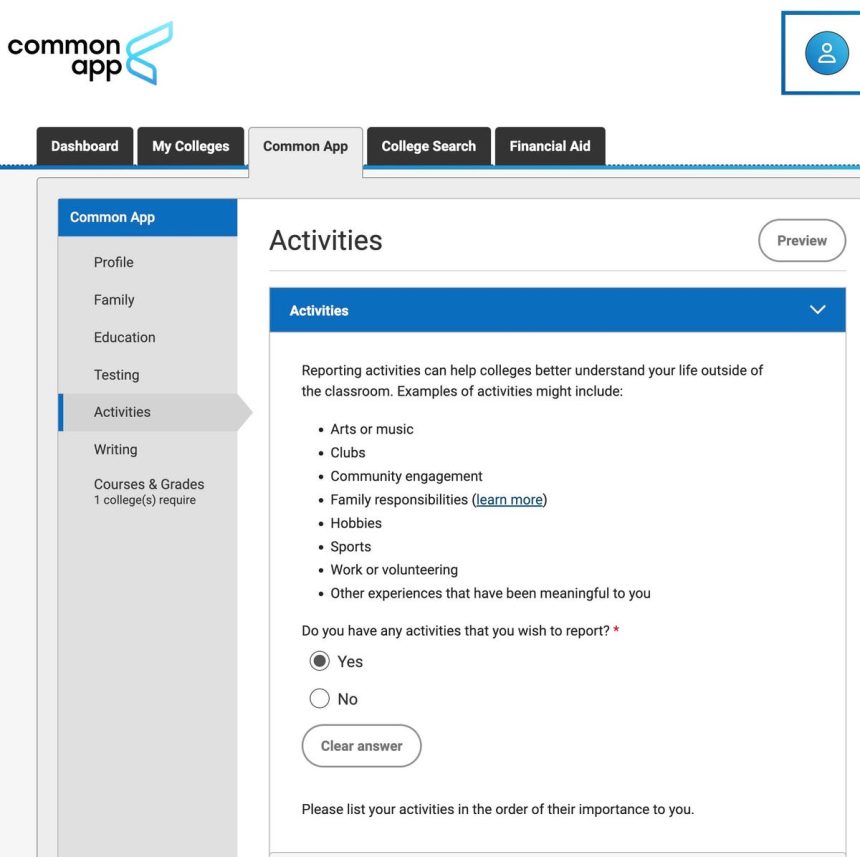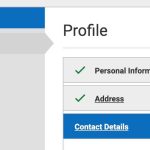The Common App is the primary way that students apply to more than 1,000 colleges and universities in the US. In 2023, it processed close to 7 million applications from 1.25 million students around the globe. But students and parents often struggle while filling out the Common App, as their answer for each question can have a major impact on their chances of admission at their dream school.
In the following series of articles, I’m breaking down every single part of the Common App, going section by section and sharing strategies and techniques to effectively fill out an application. Today, I’ll be doing a deep dive into the Activities & Writing sections of the Common App.
Ultimate Common App Guide – Article Links
Filling Out the Activities Section of the Common App
The “Activities” section is effectively your resume, where you share information about your extracurricular activities with colleges. You can add up to ten different activities in this section, along with a bunch of information about your participation in each one.
A couple of things to keep in mind, especially if you don’t have enough activities to fill all 10 slots organically. First, if you don’t have traditional activities such as clubs or sports, you can include family responsibilities, work experiences, and hobbies. Think creatively when filling out the activities section and don’t shy away from listing more unconventional activities. For example, if you spend substantial time in your garage working on car engines or woodworking, treat that as an activity, just as you would for being a member of a school club.
Additionally, if an activity has multiple layers, you might consider splitting it. For instance, if you participate in a debate club that competes in Lincoln-Douglas and Congressional debate tournaments at separate times during the year, you could list these as two distinct activities.
For each activity, there are multiple pieces of supporting information that you need to fill out, starting with the activity type. There are 20 predefined activity types for you to select from, along with “Other.” Although you can select this bear in mind that unlike other sections of the application, this one doesn’t allow you to define the other type of activity. So you’re usually better off choosing from the available categories.
Next up is the description of your position and leadership. It’s easy to list formal roles like president or treasurer but don’t forget less official yet significant positions. For instance, if you created a training library for your debate club, that reflects a leadership role as well, even if it’s not formally recognized.
After that, you’ll be prompted to enter the name of the organization. As with awards, if the name of the organization isn’t commonly recognized, take the time to explain it in parenthesis as long as it fits within the permitted 100 characters. For instance, if your environmental advocacy club’s name is Andy’s Club, specify that it’s an environmental club in the “Organization Name” field.
The description is restricted to 150 characters, so it’s crucial to prioritize the information you include. Initially, provide a brief explanation of the activity, followed by awards or recognition, and then any unique value you contributed. If possible, also state why you enjoy the activity because demonstrating authentic passion for an activity can give you an edge as an applicant.
Lastly, the application asks for details details about your participation in terms of grade level, hours per week, weeks per year. As a general principle, longer (over multiple grades) and more intense (more hours per week and weeks per year) participation in an activity is more valuable in the admissions process. Just be sure that the total reported hours per week across all activities seem realistic otherwise it may raise questions about the credibility of your application.
Finally, when it comes to future participation, selecting”Yes” for four or five activities (out of 10) can be beneficial. This shows that you didn’t just engage in an activity for the sake of college admissions and demonstrates continued interest. If any of these activities also relate to your intended major and you significant number of activities related to your intended major, even better—this signals a consistency in your interests. Conversely, if you indicate you’re not planning to continue any of these activities, it sends a mixed message.
Filling Out the Writing Section
The last core section of the Common App is the Writing Section, which contains the Common App essay, as well as an optional COVID-related prompt and additional information question. The first part of this section requires a personal essay, which is required by the majority of the higher education institutions accepting the Common App.
You can choose from one of seven personal essay prompts. While the Common App does have a text box you can write the essay with, I would recommend drafting the essay in Microsoft Word or Google Drive, as it provides more formatting options and is a more user-friendly platform. Upon triple-checking your essay, you can comfortably copy-paste it into the Common App text box or directly upload a Word document by connecting your Google Drive account with your Common App account.
Another piece of advice about the essay is to get as close to the 650-word limit as feasible. If your essay ends up being 645, 643, or 649 words, that’s fine, but if your essay is less than 600 words, you’re underselling yourself, and leaving some aspect of your personality unexplored.
The additional information section is the other part of the writing section. This is divided into two pieces: a prompt related to COVID-19 disruptions and another box to describe additional circumstances.
You should only respond to COVID-19 disruption prompt if you or your family have experienced genuine disruptions due to the pandemic. For example, if you experienced an educational disruption due to COVID-19, you can mention that in your application. Just make sure that your counselor’s recommendation letter corroborates your claim – once again, consistency is important.
While explaining disruptions, do so tastefully. Some families faced severe consequences due to the pandemic. If the worst consequence you faced was the cancellation of a debate contest you were gearing up to win, keep in perspective that others may have faced job losses or worst-case, loss of family members to the disease. Only answer this prompt if you’ve faced genuine hardship, and don’t oversell your experiences
The last piece of this section is the additional information open prompt. A frequent error applicants make is using the additional circumstances section as another resume or to elaborate on additional activities. If you do this, colleges will usually not consider this information. The things you can discuss in this box include personal disruptions, health issues, family tragedies, non-COVID health challenges, academic disruptions, disciplinary or structural challenges at school, learning challenges, or accommodations. Lastly, this 650-word response shouldn’t be an essay but rather a factual explanation written in complete sentences.
Read the full article here









